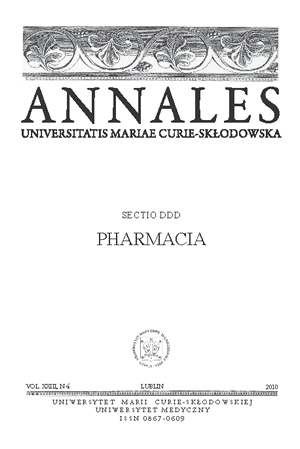Synteza i wstępne badania aktywności mikrobiologicznej wybranych pochodnych kwasu 2-benzofuranokarboksylowego
Słowa kluczowe:
kwas 2-benzofuranokarboksylowy, aktywność mikrobiologicznaAbstrakt
Praca ta jest kontynuacją naszych dotychczasowych badań nad poszukiwaniem nowych pochodnych kwasu benzo[b]furano-2-karboksylowego o potencjalnej aktywności biologicznej. W opisanej pracy otrzymaliśmy nowe halogenopochodne, które zostały poddane wstępnym badaniom mikrobiologicznym.
Bibliografia
1. Barchewitz G. et al.: Studies on the benzofuran group. XLVI. The thrombolytic effect of benzarone. Arzneim.-Forsch, 22, 553, 1972.
2. Bohnenstengel, F.I. et al.: 1H-cyclopenta[b]benzofuran lignans from Aglaia species inhibit cell proliferation and alter cell distribution in human monocytic leukemia cell lines. Naturforsch, 54c, 1075, 1999.
3. Bourgery G. et al.: Synthesis and antiarrhythmic activity of new benzofuran derivatives. J. Med. Chem., 24, 159, 1981.
4. Clinical and Laboratory Standards Institute. Antimicrobial Susceptibility testing (M100-S16). Methods for dilution antimicrobial susceptibility tests for bacteria that grow aerobically: approved standard seventh edition (M7-A7). Performance standards for antimicrobial disc susceptibility test approved standard-ninth edition (M2-A9). Clinical and Laboratory Standards Institute, Wayne, Pa, 2006.
5. Cui B., et al.: Novel cytotoxic 1H-cyclopenta[b]-benzofuran lingnans from Aglaia elliptica. Tetrahedron, 53, 17625, 1997.
6. Doshi R.K. et al.: Healthcare-associated infections: epidemiology, prevention, and therapy. Mt Sinai J Med., 76(1), 84, 2009 Review.
7. Dumontet V. et al.: New nitrogenous and aromatic derivatives from Aglaia argentea and A. forbesii. Tetrahedron, 52, 6931, 1996.
8. Erber S. et al.: 2-Phenylbenzo[b]furans: relationship between structure, estrogen receptor affinity and cytostatic activity against mammary tumor cells. Anticancer Drug Des., 5, 417, 1991 .
9. Gerard B. et al.: A biomimetic approach to the rocaglamides employing photogeneration of oxidopyryliums derived from 3-hydroxyflavones. J. Am. Chem. Soc., 126, 13620, 2004.
10. Hattori M.T. et al.: Studies on dental caries prevention by traditional medicines. X. Antibacterial action of phenolic components from mace against Streptococcus mutans. Chem. Pharm. Bull., 34, 3885, 1986.
11. Haykawa I. et al. 4-Hydroxy-3-methyl-6-phenylbenzofuran-2-carboxylic acid ethyl ester derivatives as potent anti-tumor agents. Bioorg. Med. Chem. Lett., 14, 455, 2004.
12. Hirano T. et al.: Supression of mitogen-induced profileration of human peripheral blood lymphocytes by plant lignans. Planta Med., 57, 331, 1991.
13. Hwang B.Y. et al.: Silvestrol and episilvestrol, potential anticancer rocaglate derivatives from Aglaia silvestris. J. Org. Chem., 69, 3350, 2004.
14. Karatas F. et al.: Synthesis and oxidant properties of novel (5-bromobenzofuran-2-yl)(3-methyl-3-mesitylcyclobutyl)ketonethiosemicarbazone. Eur. J. Med. Chem., 41, 664, 2006.
15. Kodama I. et al.: Amiodarone: ionic and cellular mechanisms of action of the most promising class III agent. Am. J. Cardiol., 84 (9A), 20R, 1999.
16. Kossakowski J. et al.: Synthesis and structural characterization of derivatives of 2- and 3-benzo[b]furan carboxylic acids with potential cytotoxic activity. Il Farmaco, 60, 519, 2005.
17. Kossakowski J. et al.: Synthesis and preliminary evaluation of the antimicrobial activity of selected 3-benzofurancarboxylic acid derivatives. Molecules, 15, 4737, 2010.
18. Kossakowski J. et al: Synthesis of new derivatives of 2,3-dihydro-7-benzo[b]furanol with potential pharmacological activity. Acta Pol. Pharm., 63, 271, 2006.
19. Lass-Flörl C.: The changing face of epidemiology of invasive fungal disease in Europe. Mycoses. 52(3), 197, 2009 Review.
20. Lee S.K. et al.: Cytostatic mechanism and antitumor potential of novel 1H-cyclopenta[b]benzofuran lignans isolated from Aglaia elliptica. Chem Biol Interact, 115, 215, 1998.
21. Nattel S. et al.: Amiodarone – pharmacology, clinical actions and relationships between them., J. Cardiovasc. Elektrophysiol., 3, 266, 1992.
22. Oter O. et al.: Characterization of a newly synthesized fluorescent benzofuran derivative and usage as a selective fiber optic sensor for Fe(III). Sensors and Actuators B: Chem., 122, 450, 2007.
23. Rivero-Cruz J.F. et al.: Cytotoxic constituents of the twigs and leaves of Aglaia rubiginosa. J. Nat. Prod., 67, 343, 2004.
24. Roy D. et al.: Amiodarone to prevent recurrence of atrial fibrillation. N. Engl. J. Med., 342, 913, 2000.
25. Smith R.A. et al.: Solid-phase synthesis and investigation of benzofurans as selective estrogen receptor modulators. Bioorg. Med. Chem. Lett., 12, 2875, 2002.
26. Sun W. et al.: Elektrophysiological effects of dronedarone (SR33589), a noniodinated benzofuran derivative, in the rabbit heart: comparison with amiodarone. Circulation, 100 (22), 2276, 1999.
27. Tsai I.L. et al.: Additional cytotoxic neolignans from Persea obovatifolia. Phytochemistry, 48, 1371, 1998.
28. Zawadowski T., Kossakowski J.: Acta Polon. Pharm., 1976, XXXIII, 707-712.
Pobrania
Opublikowane
Numer
Dział
Licencja
Prawa autorskie (c) 2010 Autorzy

Praca jest udostępniana na licencji Creative Commons Attribution-NonCommercial-NoDerivatives 3.0 Unported License.


